The following article was written for the Orchid Species Bulletin published by the Orchid Species Society, which is based in Brisbane, Queensland in March 2004, and updated in November 2023.
Bear in mind that any cultivation notes refer to the subtropical conditions of Southern Queensland, Australia.
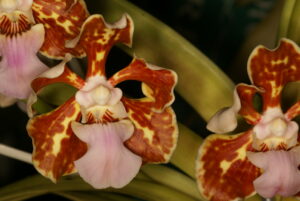
Vanda tricolor.
Vanda tricolor was first described by John Lindley in the Botanical Register in 1847. Lindley based his description upon a collection by Thomas Lobb for Messrs Veitch & Sons from Java in 1846. Lindley gave it the specific epithet from the Latin tri (three) and color (colours) in reference to the yellow, brown and rose colours of the inside of the blooms.
When first describing V. tricolor, Lindley compared it to V. hindsii, saying that V. hindsii can be distinguished by having a long many-flowered raceme, extending as far as the ends of the leaves. Unfortunately in the southeast Queensland region there have been many plants of V. tricolor raised from seed that have been labelled incorrectly as V. hindsii, V. limbata or V. insignis.
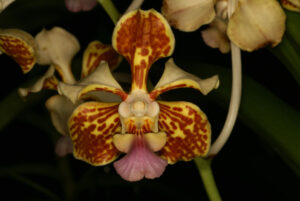
Vanda tricolor with purple coloured lip midlobe.
V. tricolor is a large erect lithophytic, epiphytic or terrestrial monopodial plant. It can produce upright stems that are 50-100 cm long. The stems bear 20 or more curved strap-shaped, pale green alternating leaves in two ranks, at about 2 cm intervals. The leaves are v-shaped in cross-section and measure 35-45 cm long and 3-4 cm broad. Upright inflorescences that are up to 25 cm long, which are shorter than the leaves are produced from nodes in the leaf axil. The racemes bear 6-10 or more, large showy, sweetly fragrant flowers. The blooms open simultaneously and are 5-7.5 cm across and last for 2 weeks or more.
Variable in colour, the sepals and petals of V. tricolor are light yellow, densely blotched bright red-brown to ochre-brown or tan on the inside. The outer surfaces are white. Its 3-lobed lip is whitish towards the base with red-brown streaks and the dominant part of the lip being the slightly convex broad midlobe is rose to deep pink.
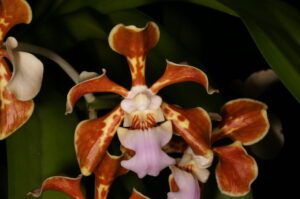
Vanda tricolor.
V. tricolor f. pallens has the pale yellow inner surface of the sepals and petals blotched with light ochre to tan. Forma pallens has a white to blush pink lip.
The lip of V. tricolor is 3-lobed, up to 2.5 cm long and 1.8 cm broad. The side lobes are squarish or oblong and incurved, while the convex midlobe is somewhat fiddle-shaped, narrowed in the middle, and deeply notched at the tip. There are 3 ridges on the lip, two of which extend to the apical margin.
In the past many varieties and cultivars of V. tricolor have been described, which are probably best treated as cultivars. I believe that V. tricolor var. suavis is best treated as a distinct species [V. suavis Lindl.].
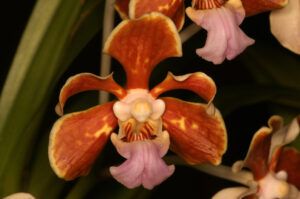
Vanda tricolor has well-coalesced markings on the sepals and petals.
Jim Comber (1982, 1990) says that V. tricolor is found in West Java and that the colour varies considerably according to locality. He adds that it thrives in the high branches of trees remaining in semi-open situations and is never found in dense, dark forests. Its habitat varies in altitude from 700-1,600 m elevation. Because of the variation in altitude V. tricolor seems to tolerate a wide range of temperatures in cultivation.
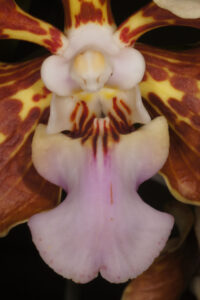
Vanda tricolor lip. Note the broad midlobe apex, which is as wide as the base.
V. tricolor grows and flowers easily in the south-east Queensland region. Plants require 50-70% shade, good air circulation and seem to do best when grown in a pot or basket. Use a coarse or well-drained medium, as the thick white roots need air circulation and prefer to dry quickly after watering. Maintain high humidity and water and liquid fertilise it regularly during the warmer months, while the root tips are active and green. Give it a slightly drier winter rest when the roots are not active, however plants should not be allowed to remain dry for long periods. I recommend 12 oC winter minimum, but plants will tolerate lower night temperatures for short periods if the leaves are dry overnight.
References:
Bechtel, H., Cribb, P. & E. Launert. (1992) The Manual of Cultivated Orchid Species. 3rd ed. Blandford Press, London.
Comber, J.B. (1982) “The Genus Vanda in Java.” The Orchid Digest, 46 (4): 124-129.
Comber, J.B. (1990) Orchids of Java. Bentham-Moxon Trust, Royal Botanic Gardens, Kew.
Cox, J. M. (1946) A Cultural Table of Orchidaceous Plants. The Shepherd Press, Sydney.
Linden, J. (1860) Pescatorea – Iconography of Orchids. 1994 English edition. Naturalia Publications, Turriers, France.
Linden, J., Linden, L., Rodigas, E. & R.A. Rolfe. (1885-1888) Lindenia – Vol. 1. 1993 reprint. Naturalia Publications, Turriers, France.
Linden, J., Linden, L., Rodigas, E. & R.A. Rolfe. (1888-1891) Lindenia – Vol. 2. 1993 reprint. Naturalia Publications, Turriers, France.
Linden, J., Linden, L., Rodigas, E. & R.A. Rolfe. (1891-1894) Lindenia – Vol. 3. 1993 reprint. Naturalia Publications, Turriers, France.
Linden, J., Linden, L., Rodigas, E. & R.A. Rolfe. (1894-1898) Lindenia – Vol. 4. 1993 reprint. Naturalia Publications, Turriers, France.
Linden, J., Linden, L., Rodigas, E. & R.A. Rolfe. (1898-1908) Lindenia – Vol. 5. 1993 reprint. Naturalia Publications, Turriers, France.
Sander, C.F., F.K. & L.L. (1927) Sanders’ Orchid Guide. Sanders Ltd., St. Albans.
Sprunger, S. ed. (1991) Orchids from the Botanical Register 1815-1847. Birkhäuser Verlag, Basel, Germany.
Veitch, J. & Sons. (1887-94) A Manual of Orchidaceous Plants. H.M. Pollett & Co., London.
